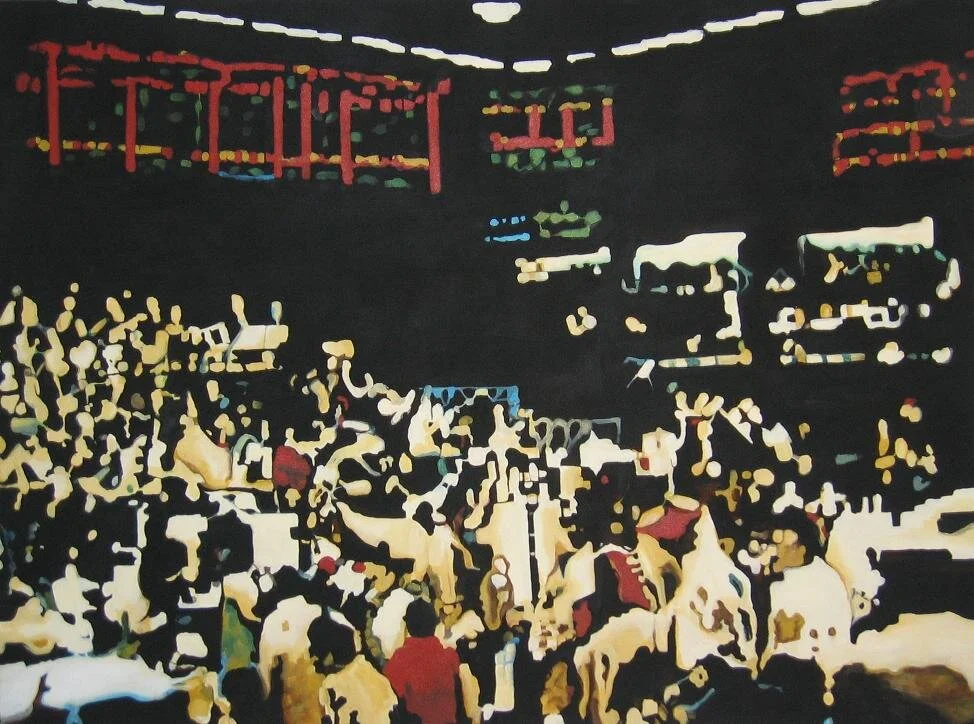



















Acrylic on Canvas, 60” x 72”, 2009, SOLD
The Dow Jones Industrial Average surged 498 points, or 6.8%, as investors welcomed details on the Treasury Department's plan to relieve banks of soured mortgage assets. Bank stocks raced higher on the news, with the financial sector of the S&P 500 gaining 18% on the day, pushing the broader index to a 7.1% gain. The Nasdaq Composite Index jumped 6.8%. Markets are at the highest levels in a month.
Wall Street Journal

Acrylic on Canvas, 60” x 72”, 2010
Washington, D.C., April 16, 2010 — The Securities and Exchange Commission today charged Goldman, Sachs & Co. and one of its vice presidents for defrauding investors by misstating and omitting key facts about a financial product tied to subprime mortgages as the U.S. housing market was beginning to falter.
Source: http://www.sec.gov

Acrylic & Oil on Canvas, 2008, SOLD
BERLIN, April 30 (AP) — The German stock exchange operator Deutsche Börse said Monday that it had agreed to buy International Securities Exchange Holdings, an options exchange in New York, for $2.8 billion.
The Deutsche Börse said that it had agreed to pay $67.50 a share for the exchange, a 48 percent premium over its closing price on Friday.
The International Securities Exchange is the largest options market after the Chicago Board Options Exchange, providing an electronic market for options on stocks of individual companies.
The New York Times

Acrylic on Canvas, 72” x 60”, 2012
Treasurys extended their slump on Wednesday, sending the 10-year yield to its highest since June, amid a steam of negative news for bonds.
President Barack Obama's agreement to extend some Bush-era tax cuts sparked alarm among Treasury investors worried about the ballooning budget deficit. Its ability to stimulate the economy also would be a negative for bonds, driving up inflation and potentially allowing the Federal Reserve to avoid extending its bond-buying program.
Those concerns have been layered on top of an overall improving economic picture that suggests higher inflation and the need for higher rates. Many investors have cashed out of their heavy Treasury holdings accumulated earlier this year in anticipation of the Fed's $600 billion bond-buying program, launched a month ago.
Source: Wall Street Journal

Acrylic on Canvas, 72” x 60”, 2012
While this may serve as a lagging indicator, especially in light of global market plunges, Daiwa Securities says net selling of equities globally increased to US$11.2 billion for the week ended Aug. 3, the biggest weekly outflow in 2011. Overall investor sentiment was weak, as non-ETF investors were also net sellers, to the tune of US$6.8 billion.
Daiwa says given recent investor concerns were U.S.-centric, the outflow from the U.S. market over the past week amounted to US$8 billion, with half of that accounted for by non-ETF investors. This overshadowed the outflow from developed Europe, which recorded net selling of US$785 million.
Finally, despite the negative sentiment, the outflow from global emerging markets (GEM) was modest, at US$1.2 billion, with Asia ex-Japan recording a marginal inflow of US$25.8 million, Daiwa notes.
Wall Street Journal

Acrylic on Canvas, 72” x 60”, 2013, SOLD
Dow Falls 650 Points Despite Mnuchin’s Bid to Reassure Investors
Monday’s more than 2% drop was the Dow’s worst performance ahead of Christmas, trumping a 1918 record
A bruising stock selloff continued Monday, erasing more than 650 points from the Dow Jones Industrial Average, as Treasury Secretary Steven Mnuchin tried to instill calm into a jittery market.
Source: Wall Street Journal

Acrylic on Canvas, 72” x 60”, 2013
Dow Falls 650 Points Despite Mnuchin’s Bid to Reassure Investors
Monday’s more than 2% drop was the Dow’s worst performance ahead of Christmas, trumping a 1918 record
A bruising stock selloff continued Monday, erasing more than 650 points from the Dow Jones Industrial Average, as Treasury Secretary Steven Mnuchin tried to instill calm into a jittery market.
Source: Wall Street Journal

Acrylic on Canvas, 60” x 48”, 2009
The Dow Jones Industrial Average dropped 280 points, setting a fresh bear-market closing low, as the financial sector collapsed again. Citigroup shares ended trading at $1.02 after falling below $1 during the session. General Motors finished the day under $2 after its auditors raised questions about the auto maker's viability. The S&P 500 dropped 4.3%.
Wall Street Journal

Acrylic on Canvas, 24” x 36”, 2009
The Dow Jones Industrial Average dropped 250 points to skid to its lowest closing level since May 1997 as stocks dropped across the board on fears that the recession will worsen. The S&P 500 dropped 3.5% to its lowest close since April 1997.
Wall Street Journal

Acrylic & Oil on Canvas, 36” x 36”, 2008
As Wall Street tried to sort through some problematic readings on the economy and new concerns surfaced about the safety of owning financial stocks, investors pushed the market down sharply today.
Stocks had been in triple-digit loss territory for most of the day, but the losses deepened after the Federal Reserve released the minutes of its Aug. 7 meeting. The Dow Jones industrial average closed down 280.28, or 2.1 percent, at 13,041.85. It was the steepest one-day decline in the Dow since Aug. 9, when it shed 387.18 points.
The Standard & Poor’s 500-stock index and the Nasdaq composite were each down 2.4 percent.
New York Times

Acrylic & Oil on Canvas, 78” x 60”, 2007
Stocks marked their biggest gains of the year as investors cheered a surprisingly large Federal Reserve interest-rate cut and hoped for more, despite signs the Fed could move back to the sidelines.
The three major U.S. stock indexes surged 2.5% or more each, enjoying their best percentage and point gains of the year. The Dow Jones Industrial Average rose 335.97, or 2.5%, to 13739.39. It was the biggest one-day percentage gain for the Dow since April 2, 2003.
Source: Wall Street Journal

Acrylic on Canvas, 36” x 36”, 2009
European financial stocks suffered sharp losses as worries about the extent of the crisis in the sector deepened. The FTSE 100 fell 4.8%, with the Dax and CAC 40 also down nearly 5%. The Dow Jones Industrial Average tumbled below the 10000 mark for the first time in nearly four years on the heels of a global market selloff spurred by continuing concern about dismal credit conditions. The Dow Jones Industrial Average plunged more than 700 points in afternoon trading to around 9600 as the credit crisis continued to deepen even amid efforts by regulators around the globe to ease the pain. The Dow Jones Industrial Average closed down 370 points after earlier falling by nearly 800 points on concern that banks remain reluctant to lend despite the efforts of regulators to unsnarl the credit crisis. Concern about how deeply the financial sector's woes are harming the broader economy contributed to a steep decline in the price of oil, which settled down $6.07, or 6.5%, at $87.81 a barrel on the New York Mercantile Exchange.
Wall Street Journal

Acrylic on Canvas, 36” x 36”, 2009
The Dow Jones Industrial Average dropped 300 points, falling to within less than a point of its November 20 closing low of 7552.29, amid yet another deep plunge in financial stocks.
The Dow Jones Industrial Average tumbled 1.2% to a new five-and-a-half year low, breaking through the previous bear-market closing low of 7552.29 hit on November 20, 2008. The blue-chip stock benchmark was pulled downward by a wave of selling in the banking sector, as components Bank of America and Citigroup each fell 14%.
Wall Street Journal

Acrylic on Canvas, 60” x 32”, 2010
Citadel Investment Group‘s main hedge funds lost 53 percent for 2008, Dow Jones reported, citing a person familiar with Citadel’s preliminary estimates.
The $10 billion Kensington and Wellington funds reportedly fell about 9 percent during the first 24 days of December, following a 13 percent loss in November, Dow Jones said. In 2007, the fund finished up 30 percent.
The news service noted that, while the drops are steep, Citadel has weathered the downturn better than some of its peers in the industry, due mainly to its size and financial flexibility.
Dealbook

Acrylic on Canvas, 18” x 24”, 2018
Citadel Investment Group‘s main hedge funds lost 53 percent for 2008, Dow Jones reported, citing a person familiar with Citadel’s preliminary estimates.
The $10 billion Kensington and Wellington funds reportedly fell about 9 percent during the first 24 days of December, following a 13 percent loss in November, Dow Jones said. In 2007, the fund finished up 30 percent.
The news service noted that, while the drops are steep, Citadel has weathered the downturn better than some of its peers in the industry, due mainly to its size and financial flexibility.
Dealbook